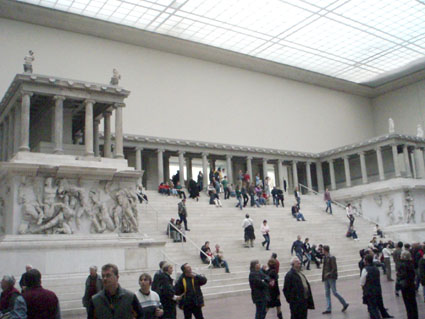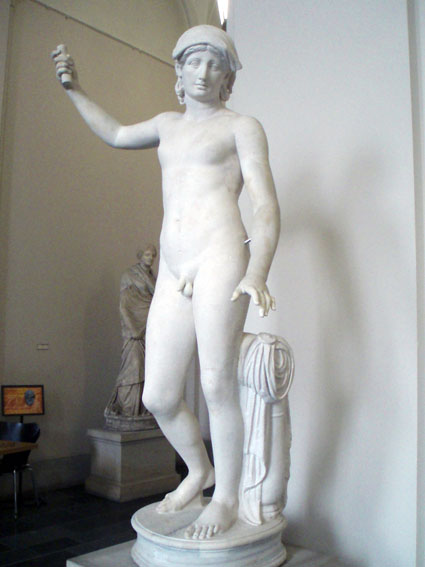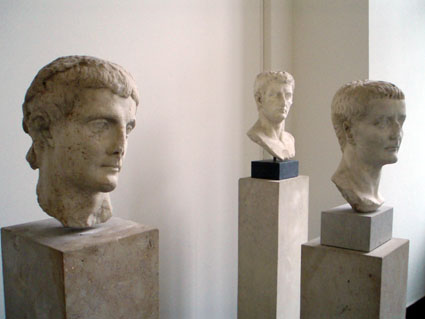A Rainy Day in Berlin
The rainy weather which had been predicted for Berlin for much of my stay finally came in spades this morning. But I was determined to do something out of doors so that I could say that I had had a good look around the city, so after my breakfast I ventured out.
My original plan was to head to the Zoo, but the crummy weather — cold rain and a driving wind — quickly scotched that idea. Instead, my curiosity was peeked by the rotating “Berliner Ensemble” sign directly across the river, so I made my way over to it.
I had thought when I arrived that this was a musical ensemble, but the large bronze statue of Bertolt Brecht told me otherwise: it was a playhouse dedicated to performing his plays. The current run included “Mother Courage”.
Despite the weather I wasn’t the only one in the small square beside the playhouse, as two elderly German women each took pictures of the other standing beside the statue of Brecht. And when they had moved on, I took mine:

Statue of Bertolt Brecht in front of the Berliner Ensemble Building
Boats looking like converted barges plied the river with tours, and I briefly thought about taking one as I sheltered under a train trestle from Friedrichstraße station, but I was intrigued by the glass-domed building not far in the distance. So I pressed on in the wet weather and found out that this was in fact the Reichstag. Couldn’t help but think of the famous war footage (restaged after the fact for propaganda purposes, but no less iconic) of a group of Red Army soldiers planting their flag at the top of this building, long ago but still within living memory

Looking at the Reichstag from Across the River Spee, with a Tour Boat in the Foreground
I also took some detailed shots in the rain of a decorative lamppost with various figures on it.

Lamp Post at the Reichstag

Lamp Post at the Reichstag – Detail (Yes, it was very wet)
I then stopped by the fringes of the Tiergarden by a row of white crosses, erected in memory of those shot while trying to escape East Germany over The Wall. An odd memorial, looking at once both impromptu and permanent, from the text typewritten in several languages, most of them quick biographies the victims, but also mixed in with messages asking for vengeance against certain individuals who had worked for the Stasi (the infamous East German secret police) and even contractors who had helped to build The Wall. In memory of those who died I left a Euro to help pay for flowers.

Part of the Memorial to Victims of the Berlin Wall

The Brandenburg Gate on a Very Rainy Day
I went to the Brandenburg Gate and took a few more pictures, and then looked up the street and saw some memorial within walking distance. I made my way over to it, and it turned out to be the Russian war memorial. Two (name) tanks flanked the entrance, then two artillery pieces, all leading to the central grand figure of a common foot soldier. All grandiose in a Stalinesque way; impressive but impassive.

T-34 Tank Flanking the Soviet War Memorial in Berlin

The Central Pillar and Statue of the Soviet War Memorial

ML-20 Artillery Piece at the Soviet War Memorial in Berlin
By this time I was beginning to feel thoroughly drenched, so I headed back to the Brandenburg Gate to where I had seen several tour buses parked.
Cheesy yes, but I wanted to see more of the city and so shelled out the 20 euros for a seat on the upper deck of the bus. I found a pair of headphones in front of me and switched the playback to English. The volume control was long gone, but I didn’t mind the volume much as I ended up sitting in front of a bunch of very loud Italians. Not knowing what “shut the hell up” was in Italian, I hunkered down, kept my peace and enjoyed the tour as best as I could. Which wasn’t really a whole much — in addition to the annoying passengers the tarpaulin over our heads leaked, and the people in front of me had to fight with the front of the lashings a few times when the wind or acceleration picked up. I did get to see more sights of the city however, including a royal palace, found out where the Holocaust Museum is and also where the local Cirque du Soleil show was playing. Most interesting was the short stretch where one of the last remaining sections of The Berlin Wall still stands.
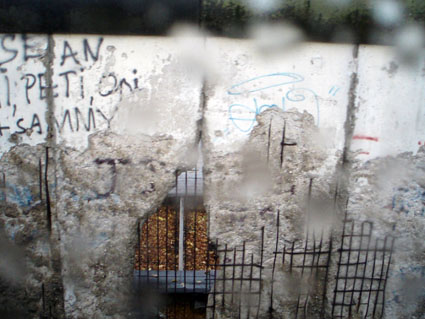
Segment of the Berlin Wall (Seen Through the Bus Window)
I got see a fair bit of the city on the bus, though the rain drops on the window meant I couldn’t do much photography. I have a much better idea as to where to head the next time I am here – hopefully when it is not as drizzly as it was today.
Then the bus turned a corner and I could see Checkpoint Charlie at the end of the street. If I couldn’t get to the zoo this was my second choice for a place to stop. It was still pissing rain, but I had to get out of the bus and check out this landmark from the Cold War.

Looking into the Former Communist Zone from Checkpoint Charlie
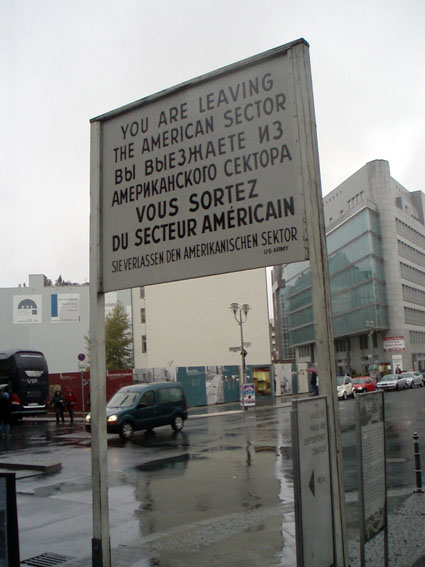
The Famous Checkpoint Charlie Sign
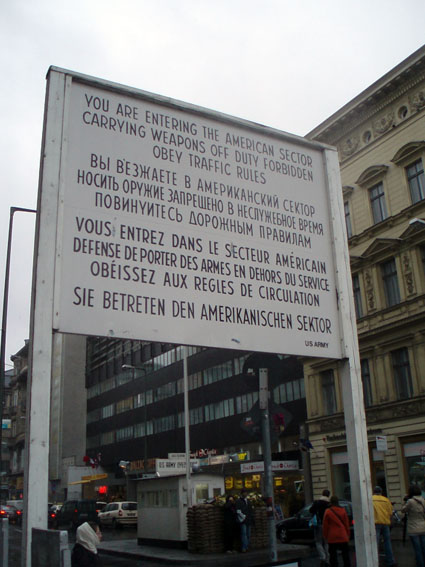
The Other Side of Checkpoint Charlie Sign (Once I got here I had to find out what it said on the other side. Now I know).
It turns out that the Checkpoint Charlie booth depicted today is a recreation of the original military checkpoint from the era when U.S. and Soviet tanks stared down at each other from the early 60s.
The Wall of course is long gone (other than for increasingly rare isolated patches of it, such as the one I passed earlier on the bus), and now tourist shops and cafes line both sides of the street (on the former U.S. side; there’s nothing much on the former Communist side, though the rain was so miserable I didn’t explore far), and cut flowers now lie on top of the sandbags in front of the outpost. A tall square sign at the end of the street depicts a young man dressed in Soviet military garb facing the Western Zone on one side, and on the other side facing the former Communist Zone is a picture of a man in a standard U.S. army uniform. Tourists lined up to have their picture taken in front of the sandbags in front of the checkpoint.
After taking some snaps of Checkpoint Charlie myself, I went to the entrance of the Checkpoint Charlie Museum just up the street.

Facade of the Checkpoint Charlie Museum
I knew from my tour book some of the history of the place: it was a private museum opened up by a West German resident as his own form of personal protest against the wall. They unfortunately had a ban on photography in the museum, and given that there were security cameras all over the place, I thought it best not to defy the ban.
The museum is in a former house, and when you go inside the original amateur, ad hoc nature of the place is immediately evident. The initial exhibits are clearly in areas that used to be a former storefront and dwelling area, with labels written in German, English and French (and occasionally, for a new class of tourist, in Russian as well), looking like they were written up using one of those old large-text typewriters long before the age of personal computers. But the information and exhibits are fascinating, most detailing how people attempted to escape from East to West Germany. There are several cars where you can see the hiding compartments where people would be smuggled out. Or the pair of suitcases where a man managed to smuggle his petite girlfriend out of the country as she lay across and inside them adjacent to each other on the luggage rack of a train. This trick was later updated in the 80s by using a pair of hollowed-out surfboards mounted on top of a car’s roof rack. There was also parts of a balloon that smuggled a couple of families out in the 70s, and the ultralight aircraft — along with video footage of the escaping flight from the plane’s vantage! — where a young man managed to ferry himself and a companion out of the GDR.
There were also exhibits detailing what people were up against as well, including the mechanism the automatically fired bullets at would-be-escapees when a trip wire was hit, the bloody clothes of at least one person who survived such an assault, and the near-iconic black and white pictures of those trying to escape from the East, not always successfully. The saddest such picture to me was that of a young dead boy who had drowned in the river — it was considered to belong to the East Germans, and West German guards were not allowed to try to save those who may have accidentally fallen in. Underneath this were some life-saving equipment and a short piece about an accord that permitted rescue efforts by the West in the latter part of the communist era.
In addition to what had obviously been the original house that contained the collection was a new wing that detailed the struggle for freedom in other countries. From the description in the Lonely Planet guidebook I had I wasn’t expecting much, but instead this was where the amateurishness of the previous exhibits went away. Starting off with a section on Ghandi’s resistance and peaceful protests against the colonial British in India, it continued to look at various uprisings in the former Soviet-controlled nations, including all of those that led to the collapse of the Eastern Block countries. Everything was well-arranged in museum quality, and the labeling professionally done. Impressive and well-organized, though most visitors seemed more interested in the previous materials on display.
I managed to sneak a picture of the following slogan, which made me laugh out loud when I read it:
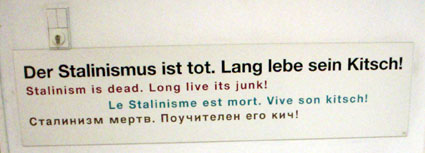
Stalinism is Dead. Long live its Junk!
Surrounding this were examples of Soviet-era posters and knick-knacks, including jumbles of medals like so much candy wrappers, a candle shaped like Stalin, and the stuffed badger found in the office of the former head of the East German secret police. Other exhibits in this area, obviously gathered together since the fall of The Wall, including chilling pieces, such as sections of Stasi files where neighbours had spied on each other, and other tales of personal betrayals.
Scattered throughout the exhibits were various pieces of art, most donated to the museum over the years. Frankly, most of it is indifferent in terms of quality or artistic nature — there’s nothing quite as iconic as Picasso’s sprawling Guernica here. For the most part I wouldn’t miss them if the majority went into storage should the museum ever undergo an overhaul. Some of the better examples were those that were painted directly onto the wall itself, a few samples of which I did manage to take some pics of in the concluding gift shop of the museum.

Art on a Piece of The Berlin Wall (from the Museum Gift Shop)

More Berlin Wall Art

Even More Berlin Wall Art
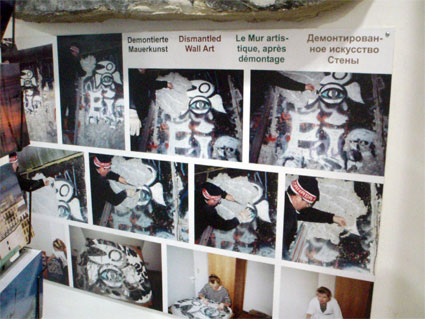
Photo Essay Showing How They Make ‘Wall Art’

The Piece of Art from the Photo Essay

Information on How to Distinguish Fake GDR Plaques (again from the Museum Gift Shop)
By the time I was done it was dark, and time for dinner. Though the tour bus I was on earlier made regular stops in front of the museum, I hadn’t seen one stop by outside the widows of he museum for a while, and concluded that they end their tours in the evening. Even the Starbucks at kitty-corner to the museum was closed. It was a Sunday after all.
The rain had by now thankfully lessened considerably, so I started trudging my way back. I started walking away from Checkpoint Charlie, thinking I would be walking more or less straight to my hotel, but when had a harder look at my map about a half hour later realized I was in fact heading further away from where I wanted to go. I had inadvertently been tracing the path of the U-Bahn subway system, so I located the nearest station, bought myself a ticket on the platform, and tried to sort out which way I needed to go. From the range of tickets offered by the ticket machine I figured out that I needed a single-journey ticket (an Einzelticket), and turned to a map to figure out how I needed to get to Friedrichstraße, which was the terminal closest to my hotel. I was lucky in that this station is at the terminal of several lines, and I was close to an interchange to led to it. I got to Friedrichstraße in under half an hour, went to a pizza place close to the hotel to get a quick bite to eat, and then made my way back to the hotel soon afterwards.
I did investigate the possibility of heading to a show, but soon realized that my English-language options were severally limited. There were two sets of cabaret shows just up and down the street from my hotel, but both were in German, and both satirical of the current government. Since I knew little of either I decided to simply stay in my room and prep for my business meeting the following day.
Tags: Berlin, Berlin Wall, Bertolt Brech, Brandenburg Gate, Checkpoint Charlie Museum, Communist, Friedrichstasse Station, Germany, Museum, Reichstag, River Spee, Soviet, T-34 Tank, Tiergarden, U-bahn
Posted in Uncategorized Comments Off on A Rainy Day in Berlin


